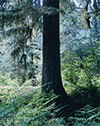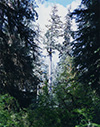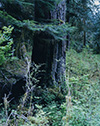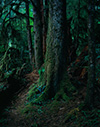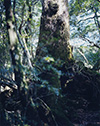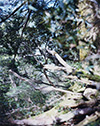past exhibition
Forest 印象と記憶 1989-2017 - Yoshihiko Ueda
Weekdays 11:00 - 20:00
Weekends and Holidays 11:00 - 18:30
Mondays and Tuesdays Closed
Entrance Fee 800 yen for over 18

artist statment
森を撮ること 上田義彦(写真家/多摩美術大学教授)
僕が森を撮ることを始めてから、約30年の時間が流れた。千年近くも生きてきた大木にとっては何でもない短い時間ではあるけれど。
1989年、アメリカ、ワシントン州Quinaultという、ネイティブアメリカンにとっての神聖な森との出逢いが、その始まりだった。その後、2011年から日本の屋久島の森を撮り始めた。この年の3月、東日本大震災で引き起こされた、大自然の容赦の無い、激烈な力による生命の破壊を目の当たりにしたことで、今一度森に入り、そこにあるはずの生命の大元を見なければと思った。そしてその後、何度となく森に入った。2017年5月、改めてQuinaultの森に入り、続けて屋久島の森、春日大社の原始林の森に入り、写真を撮った。
僕は、所謂、美しい風景写真に興味は無い。ネイチャーフォトと云われる写真もそうだ。僕が撮っているのは、「森」という、生きものたちの原初の摂理を現している、ある状態に惹かれているからだと思っている。
生けるものと、死せるものが混沌と入り乱れ、堆積した長い時間の中で、それがやがて調和となって、目の前に現れている世界。そこに身を沈め、じっと静かに眺めていると、次第に見えてくる秘密の森の調和。人には、到底創ることが出来ない、見事なまでの心地よいリズム。その状態をそのまま生け捕りにして、丸ごと写真に写したいと、森を歩きながら全身でそれを受け止めようとしている自分がいた。そんな時、森が時折見せてくれる秘密の入り口。ある日は気づかずに通り過ぎ、ある時は目の前に大きく開いて、手招きするかのように、その奇蹟の姿を見せてくれる。それは、少しでもぼんやりとしていると、すぐにその扉を閉ざしてしまうのだ。そうなると、その入り口は二度と見つけることが出来なくなる。すべては自分自身の中で起きていることだと分かっているのだけれど。
いつもそんな風に僕は、森の中を歩いている。
森には心安らぐ心地よい場所と、不思議な胸騒ぎを覚える居心地の悪い場所がある。そんな時は、一刻も早くそこを抜け出したいと、思わず足早になる。そうかと思えば、ずっといつまでも、許される限りそこに居たいと腰を据え、その木々の美しさに見とれ、時を忘れてしまう森もある。そんなことを僕に感じさせるのは、太陽の光なんだなと、森の中で空を見上げながら思ったことがある。
心地よい光の射す場所には、絶え間ない生命の循環があり、美しいリズムの森が生まれる。光の射さない暗い森は、徐々にその循環が乱れ、リズムを失い、遂には死せるものの墓場となり、命を生む力を失っていくのだと。
当然、僕も生き生きと循環している森に魅かれる、柔らかな光の射す生きるものを育む美しいリズムを持った生命の森に。森を歩きながらいつも思う、何故森を撮ろうとするのか、森の何を撮ろうとしているのか、いつもの自問自答が始まる。森ではいつでも、心地よい生命の循環のリズムをこの目で見ることが出来る。例えばそれは、美しい旋律を持つ音楽が、突然不意に聞こえてきたときのように。
そんなことを考えながら、一歩一歩、森の深い所に入っていくと、時折、森の微かなメッセージに気づく。目を離さず、ゆっくり近づいていく。もうこれ以上近づけないと感じると、静かに立ち止まる。それは、ある時は大木の輝く樹皮の一部であったり、ある時は苔むした倒木の光に照らされた一部だったりする。その周辺に視線を移していくと、真っ赤に見える粉々に朽ちた、かつて大木であった木の根元や、青く光るシダ、枯れ枝、落ち葉、それらを柔らかく包み、覆う、みずみずしい苔類。高い所の奥へ視線を移すと、木々が重なり合い、微妙な調和のグラデーションをつくっている。その中に、青く光る大木や、赤く重い色をした大木が目に留まる。そうやって、何度も、何度も繰り返し、視線を移動させ続ける。無意識のうちに同じ視線を幾度も辿っていく。大木の木肌を上下に視線を移動させ、その表面の樹皮の質感を目で確かめる。まるで、手触りを確かめるように。視線はさらに移動する。木の根元に生えた、小さな黄緑色の草の葉、青々としたシダの葉。銀色に輝く鱗のように見える剥がれ落ちた無数の樹皮、枯れ枝、それらが長い時間堆積し、朽ちたものたちを柔らかく包み込む、青々とした苔類。倒木もまた、包み込まれようとしている。その奥に見える地面もまた、その繰り返しだ。グラデーション、アンジュレーション。隣の木に目を移す。木と木の関係に、意識が奪われる。視線は、その枝に移っていく。長く横に張っている枝は、重く垂れ下がる。針葉樹の葉の上に、綿のように絡みつく馬のしっぽと呼ばれる地衣類が、朝露をたっぷり含んで水色に輝いている。その重みによって、ますます、枝は垂れ下がっているように見える。視線は、意識は、それらの色に奪われ、ディテールから色へと移っていく。銀青色の樹皮をもつダグラスファーという大木は、いつまでも見飽きることがないほど美しい。その樹皮の上に、淡く美しい黄緑色の苔が所々に広がる。樹皮の銀青と苔の薄黄緑のグラデーション、そっと目で撫でてみる。いつの間にか意識が色に奪われていることに気づく。視線がゆっくり移動する、根元に広がる無数の色の重なり合いに。赤、緑、こげ茶、青、黄、黒、銀、金、紫、橙、その濃淡へ、長い時の経過と共に、それらの色は、入り乱れ、折り重なり、溶け合う。生けるものと、死してなおも色を持ち続けるものたちとの場の色。そのまま奥へと目を移せば、それらの色のアンジュレーションが続く。高い所に視線を移すと、木々や枝葉の色の重なりが、縦糸、横糸として繊細な青のグラデーション、緑のグラデーションとして、美しい織物のように折り重なっている。隣り合う樹木や枝葉に視線が突然、移動する。時折、森の中を通り抜ける風が、木々の枝葉を揺らすせいだ。風に揺れる枝葉は、時に針葉樹であり、時に広葉樹だ。重たく垂れ下がった針葉樹の枝葉は、黒々と青く沈み、絡みついた苔がたっぷりと含まれた水に、高い木々の広げた枝を通り抜けた柔らかな光が射し、美しい淡い水色となって目に届く。味をしめた視線は枝から枝へと移動してゆく。黒々とした青と、輝く水色。そのコントラストの美しさに意識が覚醒し、輪郭やディテールに視線がどんどん移動する。目はますます細部を追いかける。木の樹皮に絡みつく苔の一つ一つに、樹皮を構成する一つ一つに。視線はそのまま倒れた大木の朽ちた幹から、こぼれ落ち堆積した、刺激的に赤い木屑の山に、幹を覆う苔の深い緑、その粉々に朽ちた質感と、柔らかくみずみずしい質感のコントラストにいちいち釘付けになる。目は移動を繰り返しながら、細部が徐々に全体へと移動していく。細部から全体への視線の運動は、ディテールから色彩へ、輪郭から量へ。視線と意識は移動と覚醒を繰り返し、その運動は、目を離さない限り、永遠に続くだろう。まるで、体中を巡る血管を、猛スピードで疾走する血液が、その肉体が死に至るまで走り続けることを止めないように。
Photographing the forest Yoshihiko Ueda (Photographer/Professor, Tama Art University)
It’s been 30 years or so since I started taking photos of forests. Though 30 years is no time at all to a towering tree that has been on the planet almost a thousand. It all began in 1989 and my encounter with the forest of Quinault in Washington State, a place of sacred significance to the local native Americans. In 2011 I then found myself photographing forest on the Japanese island of Yakushima. Witnessing the terrible destruction of life in March of that year by the merciless forces of nature, unleashed by the massive earthquake in Tohoku, I was driven to return to the forest once more, to seek out the origins of life I felt sure were there. I subsequently returned to the forest several times; in May 2017 visiting Quinault again, then Yakushima, and the virgin forest of the Kasuga Taisha shrine in Nara, photographing them all.
Conventionally attractive landscape photography holds no interest whatsoever for me. Nor do what are generally referred to as nature photos. To my mind, I take the photographs I do because I am seduced by the “forest” as a particular manifestation of the primeval dispensation of living things; a place where living and dead coexist in a chaotic jumble, over the years blending harmoniously to create the world we find there: the secret harmony of the forest that gradually becomes apparent if we submerge ourselves in the forest, and quietly observe it. A pleasant, perfect rhythm beyond human capability. I was feeling this rhythm in every fiber of my being; walking around the forest, sensing it with my whole body, desperate to capture that state alive, and capture it all in a photo. It was at this point the forest began to proffer me the occasional hidden gateway. One day I would pass without noticing; on another it would open wide, beckoning me into a miraculous realm. But if I allowed my eyes to stray for even a moment, that door would slam shut, never to be found again even though I knew the whole experience was actually inside me. It’s always like that when I walk in the forest.
In the forest there are places that are calming and comforting, and unsettling that evoke a strange, lingering uneasiness. Encountering the latter, unconsciously you find yourself walking faster, trying to get out of there as quickly as possible. Yet there are also forests that make you want to settle in, stay there as long as permitted, forever in fact; forests where the sublime beauty of the trees renders time meaningless. One day, I sensed the difference between the two: it was light. Places bathed in a pleasant light speak of the ceaseless circle of life, forming a forest with a wonderful rhythm. In dark forests where the sun doesn’t shine, that circle is broken and the rhythm lost, until eventually the forest gives way to a graveyard of dead things, losing the power to generate life. Obviously, I am as attracted as anyone to forests teeming with life; life-giving forests pierced by shafts of soft light and possessed of an appealing rhythm that nurtures living things. As I walk around a forest my usual question arises: why try to photograph the forest? What is it of the forest I am trying to capture? In the forest, I can bear witness to the soothing rhythm of life at any moment; an experience akin to suddenly encountering a passage of music with an exquisite melody. And so, pondering such matters, I make my way deeper and deeper into the forest, from time to time noticing the forest’s subtle messages. Looking hard I find places, points, that command attention. Focusing intently, I slowly approach, until sensing I can go no closer, and quietly coming to a halt. There I might find a section of glittering bark on a giant tree, or part of a moss-covered fallen tree, illuminated. Shifting my gaze to the surroundings, I spy the roots of what was once a behemoth of a tree, crumbled away to a scarlet powder; ferns glistening bluishly; dead branches, fallen leaves, moist lichen that covers it all in a gentle embrace. Gazing upward now far into the treetops, I see trees overlapping, forming a gradation of delicate harmony. My eyes are drawn especially to giants of the forest glowing green, and others of a heavy red hue. Thus my gaze flits here and there, unconsciously following the same line of sight time after time. Allowing my gaze to travel up and down the bark of a tree, I study the texture as if checking its feel with my hand. It shifts yet again: to little greenish-yellow leaves growing at the roots of a tree, to vivid green fern fronds. Innumerable fragments of tree bark peeled off and fallen, glistening silverly like fish scales; dead branches, lush, verdant mosses gently wrapping what has accumulated over the years and decayed. Fallen trees too, attempt to nestle in that embrace. All repeated on the ground behind. Gradations, undulations. My eyes move to the adjacent tree, and I lose myself in the relationship between tree and tree. My gaze shifts to the branches. Long limbs extending horizontally are bowed. The moss known as horsetail, entwined like cotton on the needles, shines aqua, suffused with morning dew. The branches seem to droop increasingly under the weight. My gaze, my whole consciousness is commanded by their colors, and moves from details to coloring. The color of bark on large trees that catch my eye, Douglas firs silvery-blue, is so arresting I could gaze on it forever. Here and there, thin patches of elegant pale greenish-yellow moss spread over the bark. I caress the gradation of silver-blue on bark and pale yellow-green of the moss softly with my eyes, and notice that without my noticing, my attention has been diverted entirely to color. My gaze moves at leisure to the layers of infinite colors extending across the roots: red, green, brown, blue, yellow, black, silver, gold, purple, orange; lighter and darker, over many years becoming jumbled together, piling up, dissolving into each other. The colors of a place of living things, and things dead yet still possessing color. Deeper in, I note these undulating colors continuing. Looking up high, the overlapping colors of trees and foliage weave a stunning brocade, delicate gradations of blue and green forming warp and weft. My gaze moves abruptly to trees and branches alongside each other, because the breeze that sweeps through the forest from time to time makes branches sway. Foliage moving in the wind is sometimes that of conifers, sometimes of broadleaf trees. The low-drooping foliage of conifers sinks in deep blackish blue, while a soft light piercing the outstretched branches of tall trees shines on water filled with tangled moss, offering up a palette of exquisite pale blue. Having acquired a taste of all this color, my gaze now moves from limb to limb, to a blue almost black in its darkness, and a glistening aqua. The wonder of the contrast awakens the senses, prompting my gaze to move rapidly to contours and details, tracing finer and finer aspects of the scene. To each moss entwined on tree bark, each piece of bark. Eyes move seamlessly from the crumbling trunk of a large fallen tree, to the mountain of decaying tree-dust, a startling red, spilled and piling there the deep green of moss coating trunk; the texture of trunk crumbled to powder; the contrast of soft and dewy textures become riveting, each and every one. My gaze shifts about, detail gradually segueing into the whole, the movement of my gaze from detail to whole, from detail to coloring, outlines to volume. Gaze and consciousness shift and awaken, shift and awaken, these movements continuing indefinitely I suppose, if I can just keep my eyes on the scene. In the same manner as blood races through veins and arteries at breakneck speed, never stopping until the demise of the flesh.
statment
僕が森を撮り始めて、30年が経とうとしている。そして今、アメリカ北西部のQuinaultの森と、日本列島の南に位置する屋久島の森、そして、日本の中心部に位置する奈良の春日大社の原生林、地理的には太平洋を挟んで存在するという以外、無関係に思える三つの森を、僕は写真に撮った。乱暴に言えば、行きがかり上、たまたま偶然、縁があって等など。しかし実は、これら三つの森には僕にとって重要な共通点がある。それはこれらの森が太古から人間によって守り継がれてきた、守らねばならないと、人に感じさせる何か大切な力があったからだということ。それを感じとる大事な力を、人は太古から受け継いできた。それを自分自身にも強く感じる。多くの森に僕は出かけた。しかしこの三つの森と出会った時、特別な感覚に襲われ、そして「撮らなければ」と、強く思った。それは言葉にならない、僕の中で起こった鋭い感覚だった。その感覚が僕に、この三つの森を撮らせることになったのだと思う。
It’s almost 30 years since I began photographing forests, and I have now captured on camera three forests seemingly unrelated, apart from geographically, all being sited on the Pacific Rim: the forest of Quinault in the northwestern United States; Yakushima in the south of the Japanese archipelago; and the virgin forest of the Kasuga Taisha shrine in Nara, central Japan. Crudely put, I suppose you could say my photographing these places was due to force of circumstance, serendipity, some kind of affinity, or suchlike. But actually these three forests share something very important to me: a kind of precious power that compels people to protect them, that has ensured their protection by humans since antiquity. The vital ability to perceive this power has passed down the generations since the dawn of mankind. I feel it myself with great intensity. I have been to many forests, but on encountering these three, found myself seized by a peculiar sensation that drove me to photograph them: a keen sensation that arose from inside of me, impossible to express in words. It was this sensation that prompted me to photograph this trio of forests.
biography
上田義彦
写真家/多摩美術大学グラフィックデザイン学科教授
1957年兵庫県生まれ。東京ADC賞最高賞、ニューヨークADC賞、日本写真協会作家賞など国内外の賞を多数受賞。
作家としての活動は独立当初から継続し、2016年までに32冊の写真集を出版。
代表作として、ネイティブアメリカンの神聖な森を撮影した『QUINAULT』(京都書院 1993)、「山海塾」を主宰する前衛舞踏家・天児牛大のポートレート集『AMAGATSU』(光琳社 1995)、自身の家族に寄り添うようにカメラを向けた『at Home』(リトルモア 2006)、屋久島で撮り下ろした森の写真『Materia』(求龍堂 2012)、数多くのポートレートや自然、スナップ、広告などを撮り続けてきた自身の30有余年の活動を集大成した写真集『A Life with Camera』(羽鳥書店 2015)を出版。
また作品は、Kemper Museum of Contemporary Art (Kansas City)、New Mexico Arts (Santa Fe)、Hermès International (Paris)、Stichting Art & Theatre (Amsterdam)、Bibliothèque nationale de France (Paris)などにそれぞれ収蔵されている。2011年よりGallery 916を主宰。
Yoshihiko Ueda
Photographer/Professor of Department of Graphic Design, Tama Art University.
Born in 1957 in Hyogo Prefecture. Recognition for his achievements includes the Tokyo Art Directors Club Grand Prize, the New York Art Directors Club Photography Award, the Photographic Society of Japan Lifetime Achievement Award, among many others.
Having pursued his artistic practice continuously since he launched his career as an independent photographer, he has published 32 photo-collections to date (2016).
Among his most noted series (monographs) are QUINAULT (Kyoto Shoin, 1993), a brooding meditation on the eponymous sacred Native American rainforest; AMAGATSU (Korinsha, 1995), a backstage study of Sankai Juku dancer-choreographer Ushio Amagatsu; at Home (Littlemore, 2006), intimate snapshots of the artist’s family; Materia (Kyuryudo Art Publishing, 2012), images of primeval forest taken on the island of Yakushima; and his recently presented A Life with Camera (Hatori Shoten, 2015), a collection of works including portraits, landscapes, snapshots, and advertising photography from his massive all works spanning more than 30 years.
Ueda’s works are in the collections of the Kemper Museum of Contemporary Art (Kansas City), New Mexico Arts (Santa Fe), Hermés International (Paris), Stichting Art & Theatre (Amsterdam), and Bibliothèque nationale de France (Paris), among others. He has been producing Gallery 916 since 2011.
overview
Forest 印象と記憶 1989-2017
上田義彦
会期
: 1月19日金曜日 - 3月25日日曜日
開館時間
: 平日 11:00 - 20:00 / 土日・祝日 11:00 - 18:30
定休
: 月曜日(祝日を除く)
入場料
: 一般 800円、大学生・シニア(60歳以上) 500円
高校生 300円、中学生以下無料(Gallery916及び916small)
トークセッション & ブックサイニング :
1月27日(土) 15:00 - 16:30 上田義彦×後藤繁雄(編集者)
2月11日(日) 15:00 - 16:30 上田義彦×伊藤俊治(美術史家)
3月3日(土) 16:00 - 17:30 上田義彦×飯沢耕太郎(写真評論家)
作品のご購入に関してはギャラリーにお問い合わせください。
TEL:
03-5403-9161
/ FAX:
03-5403-9162
MAIL:
mail[a]gallery916.com
Forest: Impressions and Memories, 1989-2017
Yoshihiko Ueda
Date
: 19 January - 25 March, 2018
Time
: Weekdays 11:00 - 20:00 / Weekends and Holidays 11:00 - 18:30
Closed
: Mondays ( Except for Holidays)
Entrance Fee
:
Adults 800 yen / College students or over the age of 60 500 yen / High school students 300 yen / Junior high school students or younger Free (Gallery916 & 916small)
Talk Session & Book Signing :
27 January, Saturday 15:00 - 16:30 Yoshihiko Ueda, Shigeo Goto (Editor)
11 February, Sunday 15:00 - 16:30 Yoshihiko Ueda, Toshiharu Ito (Art historian)
3 March, Saturday 16:00 - 17:30 Yoshihiko Ueda, Kotaro Iizawa (Photography critic)
Yoshihiko Ueda, the photographs
For enquiries regarding
the purchase of the photographs,
please contact the gallery.
TEL:
+81-(3)-5403-9161
/ FAX:
+81-(3)-5403-9162
MAIL:
mail[a]gallery916.com
© Gallery 916

